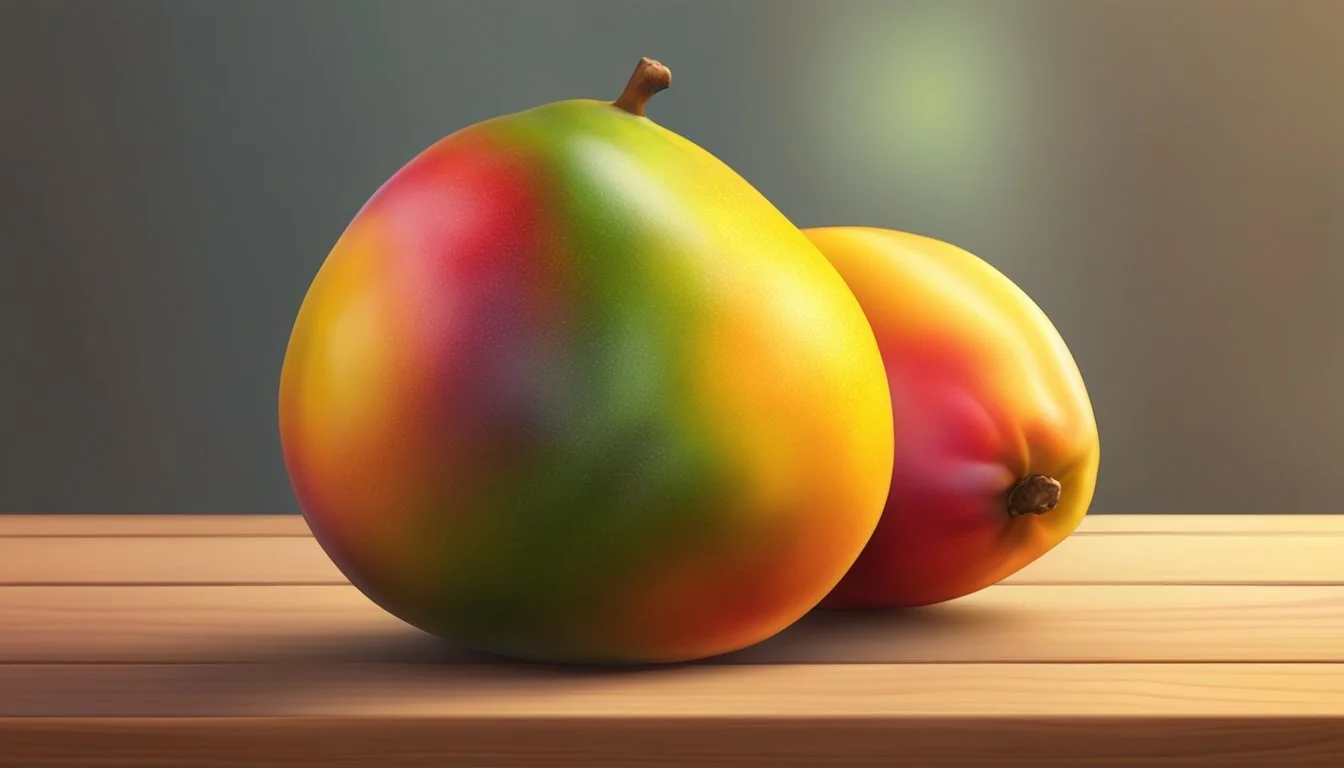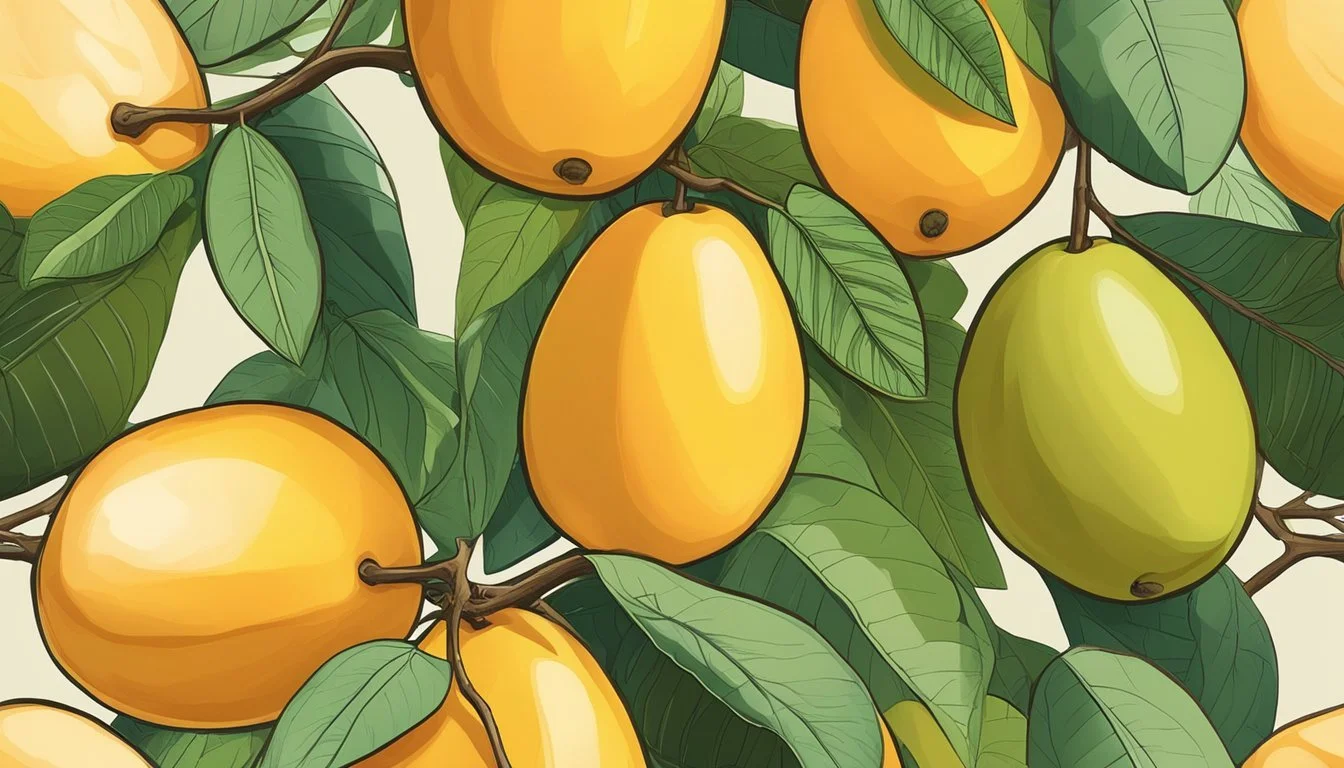How to Tell If a Mango is Ripe
Expert Tips for Perfect Selection
Determining the ripeness of a mango is essential for enjoying its peak flavor and texture. A ripe mango offers a tropical sweetness that is perfect as a healthy snack, a vibrant addition to smoothies, or as a tantalizing ingredient in both sweet and savory dishes. Judging a mango's ripeness isn't just about the color; it requires engaging multiple senses. Factors such as feel, smell, and a mango's external texture are keys to identifying when the fruit has reached optimal ripeness.
Unlike some fruits, mangoes continue to ripen after being picked, and knowing how to store them can affect their ripening process. The variety of mango can also change the indicators of ripeness, as each type might have slightly different coloration and softness when ready to eat. When selected and stored correctly, ripe mangoes can elevate a wide array of meals, enriching your diet with their nutritional benefits and diverse flavors.
Key Takeaways
Sensory cues such as feel, smell, and appearance guide in determining mango ripeness.
Mango ripening can be managed through proper storage methods.
Different mango varieties may exhibit unique ripeness indicators.
Identifying Ripe Mangoes
When choosing the perfect mango, one must consider several sensory indicators such as color, aroma, texture, and specific physical characteristics like shape and stem end that are telltale signs of ripeness.
Color as an Indicator of Ripeness
Depending upon the variety, ripe mangoes often exhibit a vibrant range of colors from green to yellow, orange, or red. While color alone can be misleading due to varietal differences, a consistent color without green patches typically suggests a ripe mango. However, some mangoes remain green even when ripe.
Aroma and Smell: The Scent of Ripeness
A ripe mango will emit a strong sweet scent, particularly near the stem end. The more intense the fragrance, the more likely it is that the mango is ready to be enjoyed. The absence of aroma may suggest an unripe fruit or, conversely, an unpleasant, sour, or alcoholic smell can indicate overripeness.
Texture and Firmness: How to Feel for Ripeness
Firmness: The ideal ripe mango will yield slightly to gentle pressure, indicating soft, succulent flesh inside. Texture: It should be not too hard (unripe) nor too squishy (overripe). Uniform give across the mango's body is an indication of even ripeness.
Additional Ripeness Clues: Shape and Stem End
Observing the mango’s physical features can also provide clues. Shape: Look for a fuller, rounder form, as this is a sign the internal flesh has developed. Stem End: A smooth, round stem end can be a sign of fruit maturity as it can indicate the mango was not prematurely harvested.
Different Varieties and Their Ripeness Signs
Each mango variety has unique signs that indicate its ripeness. It is essential to recognize these signs to ensure you're enjoying the fruit at its best taste and texture.
Ataulfo Mangoes
Ataulfo mangoes, also known as Champagne or Honey mangoes, are smaller with a kidney-like shape. They are ready to eat when the skin turns a deep golden color and has a slight wrinkling. Softness and a fruity aroma near the stem are also indicators of an Ataulfo mango's ripeness.
Tommy Atkins Mangoes
Tommy Atkins mangoes are known for their strong resistance to handling and transportation. They have a dark red blush with green and yellow undertones and can be ripe while still mostly green. One should check for a slight give to the fruit's firmness and a sweet scent to determine ripeness.
Keitt Mangoes
Keitt mangoes are large and oval with a dark green color that may retain greenness even when ripe. They become slightly soft to touch when mature, and their flesh's sweetness intensifies, indicated by a fruity aroma at the stem end.
Haden Mangoes
Haden mangoes have bright red skin with green and yellow shades and small yellow dots. Ripe Haden mangoes give off a pleasant fragrance and have a slight give when pressed gently. The more yellow on the skin, the riper the fruit is likely to be.
Ethylene and the Ripening Process
Ethylene gas plays a crucial role in the natural ripening process of mangos. Its regulation can expedite ripeness, yielding fruit that's ready for consumption sooner.
Understanding Ethylene Gas
Ethylene is a natural plant hormone produced by many fruits, including mangos. It acts as a signaling molecule, initiating the ripening process. When a mango releases ethylene, it triggers a series of reactions that lead to changes in the fruit's texture, softness, sweetness, and skin color.
Production: Mangos naturally generate ethylene gas as they mature.
Effects: Ethylene promotes changes in the fruit's skin color from green to yellow, red, or orange, depending on the variety. It also softens the flesh and enhances sweetness.
Accelerating the Process: The Paper Bag Method
Storing a mango in a paper bag at room temperature can accelerate ripening. The bag confines the ethylene gas close to the fruit and increases its concentration around the mango, thereby speeding up the process.
Materials: Use a brown paper bag that will allow for some air circulation while containing the ethylene gas.
Method: Place the mango inside the paper bag and fold the top of the bag closed. Optional addition of apples or bananas can boost the level of ethylene gas in the bag because these fruits also emit the gas.
Storing Mangoes for Optimal Ripeness
Proper storage of mangoes is essential to maintain their freshness and achieve optimal ripeness. Mangoes require specific temperature and humidity conditions, either at room temperature for early ripening or in the refrigerator to prolong their shelf life once ripe.
Room Temperature Storage
Storing mangoes at room temperature is ideal for unripe mangoes as they need warmth to ripen properly. They can be placed on a countertop away from direct sunlight and should be checked regularly. The ideal room temperature range to encourage even ripening is between 70°F and 75°F (21°C - 24°C). A ripe mango will yield slightly to gentle pressure and emit a sweet, fragrant aroma. A visual indicator of ripeness is a change in skin color, often to a more golden or creamy hue.
Using the Refrigerator to Slow Ripening
Once mangoes reach peak ripeness, their shelf life can be extended by transferring them to the refrigerator. The cool environment slows down the ripening process and can preserve the fruit's quality. Mangoes should be stored in the crisper drawer to provide a more stable temperature and higher humidity, ideally between 50-55°F (10-13°C). It is crucial to avoid temperatures below 50°F, as this may cause cold injury to the fruit and result in off-flavors. Refrigerated mangoes can stay fresh for up to two weeks, but their flavor is best when used within a few days of reaching ripeness.
Preparing and Cutting Ripe Mangoes
When a mango is ripe, its sweet fragrance and slightly soft texture indicate it's ready to be sliced. Proper technique in cutting maximizes the fruit's use and preserves its delightful flavor for any recipe.
Techniques for Cutting Mangoes
To cut a mango, one begins with a clean knife and cutting board. The mango should be rinsed with cool water. Then, find the stem and place it at the top. The pit is oriented from stem to bottom and a cut should be made approximately 1/4″ from the midline on each side. The resulting two outer sections contain the majority of the flesh. The center section will include the pit.
To cube mango for recipes like fruit salads, score each fleshy section without breaking the peel. Scoring is done by making parallel cuts through the flesh, turning the mango, and repeating to create a grid pattern. The cubes can then be scooped out with a spoon.
Pit Removal and Slicing
Pit removal involves cutting the remaining flesh from around the pit. This is done by slicing alongside the pit, maximizing the amount of mango flesh retrieved. Any additional flesh clinging to the pit can be carefully trimmed away.
For slicing, once the two main fleshy sections are free from the pit, one can either create slices by cutting parallel lines into the flesh or alternatively cube as previously described. These slices are perfect for eating on their own or adding to various dishes.
Recipes and Usage Ideas
Selecting a perfectly ripe mango opens up a world of culinary possibilities. From decadent desserts to refreshing beverages, a ripe mango can significantly enhance the flavor profile of various dishes.
Desserts and Sweet Creations
Mangoes bring a natural sweetness and distinctive tropical flavor to any dessert. A classic mango cheesecake for example, benefits from the rich and creamy texture of ripe mango puree. Incorporating the puree into the filling aids in achieving a smooth and indulgent dessert.
Mango Sorbet: Use ripe mango chunks, blend until smooth, and freeze for a simple yet vibrant frozen treat.
Mango Pudding: Combine ripe mango puree with gelatin and cream to create a silky dessert with intense mango flavor.
Salads and Savory Dishes
The sweet flavor profile of mangoes adds a unique twist to savory dishes as well, particularly in salads where their sweetness can balance more acidic or bitter ingredients.
Mango Salad: Toss cubed ripe mangoes with mixed greens, red onions, and a citrus vinaigrette for a bright salad that highlights the mango's sweetness.
Grilled Chicken with Mango Salsa: Top marinated grilled chicken breasts with a salsa made from diced ripe mangoes, tomatoes, onions, and cilantro for a sweet and tangy flavor combination.
Beverages: Mango Smoothies
Beverages, particularly smoothies, take full advantage of mango's natural creaminess. Ripe mangoes eliminate the need for added sugars and help to create thicker, more satisfying drinks.
Classic Mango Smoothie: Blend ripe mango chunks with yogurt and a touch of honey for a creamy and healthful smoothie.
Tropical Smoothie: Combine ripe mango with pineapple, coconut milk, and a dash of lime juice for a smoothie that transports you to the tropics.
Tips for Selecting the Sweetest Mangoes at the Store
When at the grocery store, shoppers can employ several strategies to identify the sweetest mangoes. Sweetness in mangoes is often indicated by a combination of tactile, visual, and olfactory cues.
Appearance: Look for a mango with a vibrant color. While color might not be an absolute indicator due to varietal differences, a healthy skin color, often golden yellow or with a blush, suggests ripeness.
Firmness: Gently press the mango with your fingertips. A ripe mango will yield slightly under pressure, but shouldn't feel mushy. Mangoes that are too firm may be underripe.
Aroma: Sniff the stem end of the mango. Ripe mangoes typically emit a sweet, fragrant aroma.
Stem Sap: A presence of sap at the stem may indicate ripeness. However, be aware that sap residue could look like dark spots or lines near the stem.
Skin Texture: While slight wrinkling can suggest overripe, some perfectly ripe mangoes possess a fine texture on their skin.
The table below summarizes what shoppers should look for:
Appearance: Vibrant skin color, typically yellow or red
Firmness: Slight give when pressed gently
Aroma: Sweet fragrance near the stem
Stem Sap: Sap presence indicating ripeness
Skin Texture: Fine texture on skin of ripe mangoes
Shoppers should combine these tips to select the sweetest mangoes for immediate consumption or ripening at home.
Common Mango Concerns
In managing mango ripeness, one must adeptly navigate the challenges of underripe and overripe fruit while also mitigating the risks of bruising and damage during handling.
Dealing with Underripe and Overripe Mangoes
Underripe mangoes are firm to the touch and often too tart for enjoyable consumption. The fruit should yield slightly under pressure when ripe; if it doesn't, it can benefit from a few days at room temperature to soften and develop its sugars. For those who encounter an overripe mango, characterized by excessive softness or a strong, fermented smell, consumption is still possible. The overripening process can lead to a sweeter, softer fruit perfect for purees or smoothies.
Underripe Mango:
Firmness: Hard to the touch.
Solution: Allow to ripen at room temperature.
Overripe Mango:
Softness: Excessive give under pressure.
Odor: Strong, fermented smell.
Usage: Ideal for purees, smoothies, or baking.
Preventing Bruising and Damage
Mangoes are susceptible to bruising when mishandled. If a mango is dropped or squeezed too forcefully, internal bruising may occur, causing brown discoloration and a mushy texture. To prevent this, one should handle mangoes with care, much like one would treat a delicate peach or pear. Store mangoes at room temperature away from heavier fruits that can compress and damage them.
Avoiding Bruising:
Handle with care: Treat mangoes gently to prevent damage.
Proper storage: Keep them at room temperature, not under the pressure of heavier items.
Frequently Asked Questions about Mango Ripeness
Q: How can one assess the ripeness of a mango?
A: To evaluate if a mango is ripe, conduct a press test by gently squeezing the fruit. It should yield slightly to pressure, signaling ripeness. A ripe mango often feels heavy for its size, indicating good moisture and juiciness.
Q: Are there visible signs that a mango is ripe?
A: Yes, look for a mango with a plump area around the stem; this suggests maturity. A ripe mango's skin may also feature a yellow or orange hue, but keep in mind that some varieties retain a green color even when ripe.
Q: What should a ripe mango smell like?
A: A ripe mango emits a sweet and fruity aroma at the stem end. This fragrance is a reliable indicator of the juiciness and flavor within.
Q: Can the weight of a mango indicate ripeness?
A: A ripe mango tends to feel heavy for its size due to the internal moisture content that contributes to its juiciness.
Q: How is the 'finger test' useful in checking mango ripeness?
A: The 'finger test' involves pressing into the mango with your thumb. If the flesh indents slightly and bounces back, it indicates the mango is ripe. If it feels too soft or mushy, it may be overripe.
By understanding these aspects, anyone can confidently select a ripe mango for their enjoyment. Remember that a mango's variety can affect some of these indicators, so experience with specific types may refine one's ability to choose the best fruit.
Mango Nutritional Information
A mango is not only a delicious fruit but also a powerhouse of nutrients. In a single serving, one can expect a healthy dose of essential vitamins and minerals.
Vitamins: Mangos are rich in vitamin C, a potent antioxidant that boosts immune system function and skin health. They also provide a good amount of vitamin A, which is crucial for eyesight, as well as vitamins E, K, and the B vitamins, including B6 and folate.
Vitamin C: Antioxidant, immune support
Vitamin A: Eyesight, skin health
Vitamin E: Skin, vision, reproduction
Vitamin K: Blood clotting, bone health
Vitamin B6: Brain health, energy levels
Folate: Cell function, tissue growth
Minerals: When it comes to minerals, mangos offer a noteworthy content of potassium, magnesium, and a small amount of calcium, iron, and phosphorous.
Potassium is vital for maintaining healthy heart function and regulating fluid balance.
Magnesium plays a role in over 300 enzymatic reactions, including energy creation and protein formation.
Calcium, Iron, and Phosphorous are present in smaller amounts but are essential for bone health, oxygen transport, and maintaining strong bones and teeth, respectively.
The dietary fiber in mangos aids in digestion and promotes feelings of fullness, contributing to weight management. Although mangos are naturally sweet, they have a low to moderate glycemic index, making them a suitable option for blood sugar management.
In terms of caloric content, a medium-sized mango has approximately 150 calories, making it a nutrient-dense fruit choice that provides significant nutritional benefits without a high calorie count.
Exploring Mango Varieties Around the World
Mangoes grace markets and tables around the world with their sweet, tropical flavor. There are hundreds of types of mangoes, each boasting distinct characteristics. Here are some popular mango varieties that mango enthusiasts might encounter:
Julie: Grown in the Caribbean, the Julie mango stands out for its small size and delightful taste. It is renowned as a prolific bearer of fruit, despite the small stature of its tree.
Ataulfo: Known in some areas as the "Honey" or "Champagne Mango," this small Central American variety is cherished for its exceptionally sweet, rich flavor and smooth, fiberless flesh.
Baileys Marvel: Hailing from Southwest Florida, the Baileys Marvel mango is a superb, juicy variety with a tangy yet sweet, aromatic flavor profile. It also showcases a striking peach blush over a freckled yellow base.
When selecting a ripe mango, the texture should give slightly under gentle pressure, and it often presents a fruity aroma at the stem end. Different varieties may display unique hints of color or texture changes as they ripen.
For a mango expert, the rich diversity of mangoes provides a fascinating study into the adaptability and variety within a single fruit category. The world of mangoes is vast and varies greatly from region to region, offering a wealth of flavors to discover.
The Cultural Significance of Mangoes
Mangoes, often hailed as the king of fruits, have a rich cultural heritage, especially in tropical regions where they naturally thrive. They are more than just a sweet tropical fruit; they are ingrained in the fabric of many cultures.
India's National Fruit: Mangoes originated in India over 4,000 years ago. In India, they are not only consumed during the hot summer months but also celebrated in festivals and religious rituals. Mango leaves are also used for decorations and rituals, symbolizing life and fertility.
Symbol of Love: In various cultures, mangoes symbolize love and friendship. They are regularly given as gifts and shared as a gesture of goodwill. The practice reflects the fruit’s importance in fostering community ties.
Literature and Art: Mangoes have made appearances in literature and historical accounts, becoming a symbol of prosperity and wealth. Their influence extends into art, where they have been depicted in paintings and carvings, signifying prominence.
Caribbean and Latin American Culture: In the Caribbean and Latin American regions, mangoes are a staple in the local diet and have also influenced their music, storytelling, and art, showcasing the fruit's versatile impact on culture.
India: Festivals, religious rituals, national fruit
Caribbean: Local cuisine, music, art
Latin America: Storytelling, social gatherings
Through their deep cultural roots, mangoes illustrate how a simple fruit can become intertwined with the identity and heritage of people around the world.
How to Incorporate Ripe Mangoes in Everyday Meals
Ripe mangoes are versatile fruits that add a tropical twist to any meal. This section provides inventive ways to enjoy the rich flavor and succulent texture of ripe mangoes from the start of your day to the evening.
Breakfast and Brunch Ideas
Smoothies: Blend ripe mango chunks with yogurt, and a splash of orange juice.
Oatmeal: Top warm oats with diced mango and a drizzle of honey.
Pancakes: Fold mango puree into the batter or use fresh mango slices as a topping.
Yogurt Parfaits: Layer Greek yogurt with mango cubes, granola, and a touch of cinnamon.
Mangoes in Lunch and Dinner
Salads: Toss ripe mango cubes into a quinoa salad with cucumber, mint, and a squeeze of lime juice.
Tacos: Fill warm tortillas with grilled fish, ripe mango salsa, and cabbage slaw.
Stir-fries: Sautee ripe mango with bell peppers, onion, and protein of choice; serve with rice.
Chutneys: Simmer ripe mangoes with vinegar, sugar, and spices until thickened, perfect with grilled meats.
Mango Dessert: Craft a simple mango mousse or fold mango chunks into cake batter before baking.
Pairing Mangoes with Other Fruits
Pairing ripe mangoes with other fruits can create a harmony of flavors, transforming simple fruit servings into delightful culinary experiences. Each combination enhances different attributes of the mango's taste profile.
Mango and Banana Combinations
Mangoes and bananas share a tropical origin, and when combined, they complement each other’s sweetness and texture. A classic pairing is a mango and banana smoothie, where the creaminess of banana perfectly balances the tanginess of the mango. For a simple dessert, mango and banana slices can be layered with yogurt and a drizzle of honey.
Mango and Avocado Mixes
Mangoes and avocados are both rich and creamy, but they differ in flavor. This contrast makes them excellent partners in dishes such as salads or wraps. Try adding diced mango and avocado to a chicken salad for a refreshing twist. The mango provides a sweet note while the avocado adds a buttery texture.
Tropical Fruit Salsa Variations
A tropical fruit salsa is a vibrant addition to any dish, especially when it includes mangoes. They are often the star ingredient, offering a burst of sweetness that balances the acidity of other fruits like pineapples and peaches. Here is a simple tropical salsa variation:
Ingredients:
1 ripe mango, diced
1/2 cup diced pineapple
1/2 cup diced peaches
1/4 cup finely chopped red onion
2 tablespoons chopped cilantro
Juice of 1 lime
Salt and pepper to taste
Instructions:
Combine all the fruit and onion in a bowl.
Add cilantro, lime juice, salt, and pepper.
Gently toss to mix the flavors.
This salsa could serve as a complement to grilled fish or chicken, or even as a unique dip with tortilla chips.





